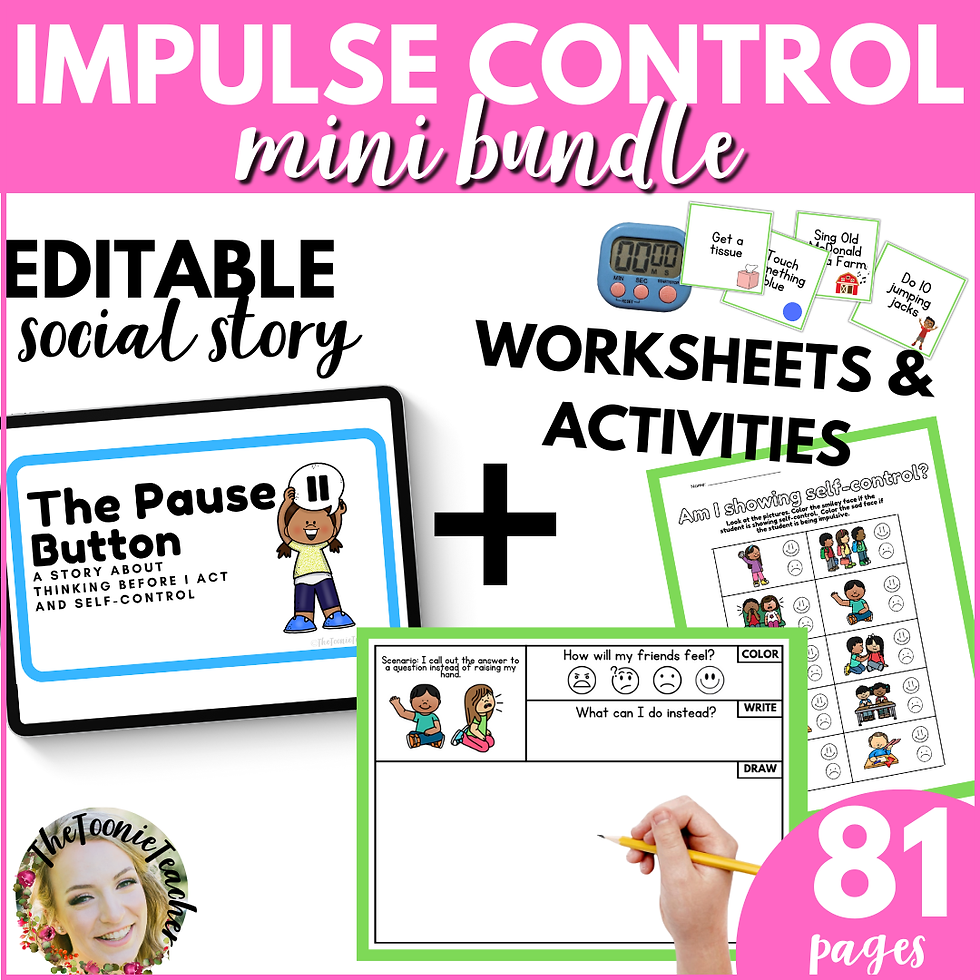How to Teach Self-Control: 8 Ways to Help Your Students Think Before They Act
- carolynr
- Apr 13
- 6 min read

Self-control is one of those skills we often wish our students had… but don’t always realize needs to be explicitly taught—especially for our neurodiverse learners.
For students with ADHD and other neurodevelopmental differences, impulse control isn’t about being ✨bad✨ or ✨disruptive✨—it’s a brain-based challenge. And the good news? Self-control can be taught, practiced, and celebrated just like any other life skill.
Before teaching self-control, one simple way to address impulsivity is by ensuring that the work is tailored to the student's level. Tasks that are overly difficult or lengthy can be challenging for any student. It's important to offer choices and creative methods for expressing ideas.
Here are 8 practical, neurodiversity-affirming strategies on how to teach self-control (P.S. Most of these are supported in my Impulse Control & Self-Control Mini Bundle—perfect for saving time and supporting student growth!)
1. Use Social Stories to Teach Self Control

Before kids can use self-control, they need to understand what it is. Social stories are a great way to explain the why behind waiting, stopping, and thinking before acting.
Use short, visual stories that describe real-life situations and walk students through what using self-control looks like and feels like.
It’s important to note that the research on social stories shows mixed results. Some of the studies in a literature review conducted by Daub & Huber (2020) found little to no impact on behavior change.
However, researchers like Kokina & Kern (2010) suggest that social stories can still be a valuable first step in teaching a new social behavior. They recommend using them as part of a broader intervention plan, with additional supports added as needed to help students successfully demonstrate the behavior — for more ideas on effective teaching strategies, just keep reading.
✨ Included in my bundle: A ready-to-go social story that introduces self-control in a positive, student-friendly way.
2. Incorporate Visual Supports for Self Control
Visuals are a game-changer—especially for students with ADHD or other executive functioning challenges.
Consider using visuals like:
✅Stop, Think, Act poster on the wall
✅Individualized desk reminder
✅Visual count down timers
✅Raise Hand visual to use during group instruction
These visual cues help prompt self-regulation in the moment.
Visuals are also helpful to reduce reliance on verbal or adult-led prompting. Fading out prompts by simply pointing to the visual for the student to notice it can be a fantastic way to build independence in self-regulation and control.
3. Teach the Difference – Self-Control vs Impulsive Behavior
Once the idea is introduced, we move into discrimination training—fancy term, simple goal. You're helping students tell the difference between using self-control and acting impulsively.
Think: real-life examples, sorting tasks, and reflection questions.
Give them scenarios or behavior samples and ask, “Was that using self-control or acting on impulse?” It’s about building awareness, not shame.
Try this from my bundle: Worksheets that walk students through examples and help them label behaviors in a non-judgmental, accessible way.
Big note: Just because a student has mastered discrimination training within worksheets and sorting activities, don’t expect this to automatically generalize to real life. We need to strategically generalize these skills incrementally—which I’ll talk about next!
4. Model Self-Control Out Loud
One of the most powerful (and relatable!) ways to teach self-control is to think out loud. When you model your internal monologue, you’re not just showing students what to do—you’re showing them that self-control is a process, not something that magically happens. You’re making it real and accessible.
For example, you might say:
“I really want to check my phone right now, but I’m going to wait until the timer goes off.”
“I’m feeling really frustrated with this math problem, but I’m going to take a deep breath and try again instead of giving up.”
When you narrate these moments, you’re giving students an inside peek into how you manage impulses and make choices. And here’s the key: it’s okay to struggle.
Modeling that self-control can be challenging—even for adults—helps normalize the experience for your students. It’s perfectly fine to express that it's hard, but that doesn’t mean we can’t do it!
This kind of open, vulnerable modeling shows them that self-control is a skill that can be learned and improved over time.
Plus, it reinforces the idea that making mistakes is part of the process. You’re giving them permission to try, fail, and try again, which is incredibly powerful for building self-regulation.
5. Play Games that Build Self-Control

Games provide a fun, low-pressure space where students can practice important self-control skills like stopping, waiting, listening, and thinking.
Games help bridge the gap between worksheets and real-life situations, making them a fantastic next step for students to apply what they've learned in a more dynamic, social setting.
When choosing games, look for ones that involve waiting and racing. A little competition can also be super helpful in motivating students to practice impulse control—just make sure it's friendly and fun, not overly intense.
Games like these challenge students to pause, think, and control their impulses in the heat of the moment. Some excellent classic choices include:
✅Freeze Dance
✅Red Light, Green Light
✅Simon Says ✅Octopus
These games introduce real-world timing—waiting for a turn, stopping when asked, or controlling their actions during a race—which is a perfect bridge to practicing self-control in real-life situations.
✨ The bundle includes two ready-to-print games designed specifically to target self-control skills, all while keeping students engaged and having fun!
6. Practice in Real-Life Situations (With Support!)

After students have practiced self-control in structured games and worksheets, it’s time to bring the skills into the real world—because that’s where the magic happens!
This is where self-control needs to translate from the worksheet to the classroom, playground, or home. But real-life situations often require more support and scaffolding than a game or worksheet, and that’s perfectly okay.
Start with simple, controlled scenarios: Have students practice waiting for a turn, raising their hand, or waiting in line. These everyday situations are the perfect opportunity to reinforce self-control and self-regulation.
Visual reminders are a fantastic tool here—using a quick visual cue (like a "wait your turn" card) or a reminder of the expected behavior can give students the gentle nudge they need.
It’s also important to model self-control and use verbal prompts during these situations to reinforce the behavior you want to see. For example, before a student has to wait their turn, remind them: “Remember, you can raise your hand to speak, just like we practiced!”

💡 Bonus Tip: Gamify waiting!
This is a fun, engaging way to practice patience without feeling like a “test.”
Try challenges like counting how many peers are wearing a certain color in line or noticing how many times the teacher uses a specific word in a story.
Many students, especially those with ADHD, actually find that they can focus better when they have a secondary task to engage their mind while still participating in the main activity.
7. Reflect on How It Went
After a real-life moment (or even after a game), help students reflect:
✅“Did I use self-control?”
✅“What helped me wait?”
✅“What was hard?”
✅“What can I try next time?”
By reflecting, students build metacognition—“thinking about thinking.” It allows them to recognize their behaviors, understand why they act the way they do, and actively take ownership of their growth. This process turns self-control into a skill they can continue to refine, rather than just a rule to follow.
✨ In my bundle, you’ll find daily reflection sheets that guide students through these questions, allowing them to track their progress and get better over time. These sheets are an easy way to make reflection part of the daily routine, reinforcing the growth mindset.

8. Celebrate Small Wins
Self-control is a skill that takes time, repetition, and LOTS of encouragement. Celebrate the effort, not just the outcome:
“I saw you pause before answering—that’s awesome self-control.”
“You waited your turn even when it was hard. That’s a big deal.”
And remember—progress won’t be linear. That’s normal. Your steady support matters more than you know.
Final Thoughts
When we teach self-control with empathy, clarity, and playfulness, we give students tools that go far beyond the classroom. And when we support our neurodiverse learners in a way that honors their brains, we create classrooms where all kids can grow.
Ready to get started with everything mentioned above? Grab my Impulse Control & Self-Control Mini Bundle HERE—it’s packed with visuals, stories, games, worksheets, and reflection tools that make teaching self-control easier (and more fun) for everyone. Whether you’re looking for activities to use in the classroom, at home, or during after-school programs, this bundle has got you covered.
REFERENCES:
Daub, Alexandra & Huber, Tonya. (2020). Effectiveness of Social Stories on Social Skills for Elementary-Aged Students with Autism: A Literature Review. International Journal of Education. 12. 12. 10.5296/ije.v12i4.17759.
Kokina, A., & Kern, L. (2010). Social story™ interventions for students with autism spectrum disorders: A meta-analysis. Journal of Autism and Developmental Disorders, 40(7), 812-26. https://doi.org/10.1007/s10803-009-0931-0










Comments